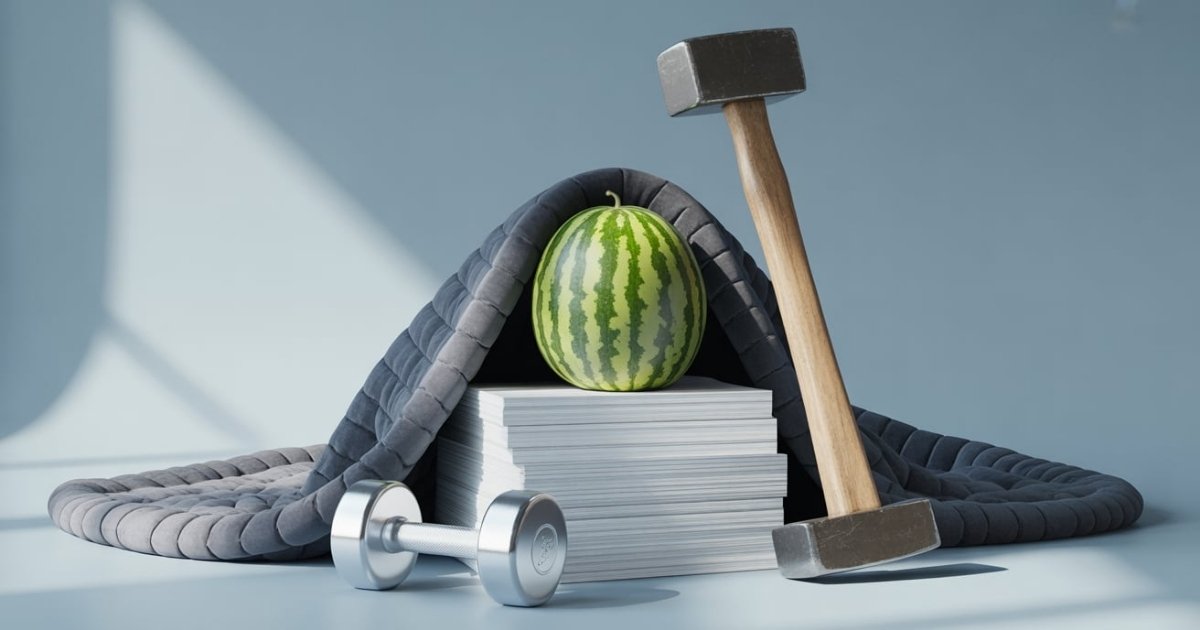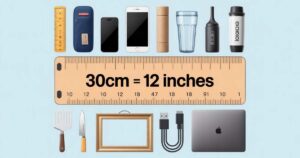Have you ever found yourself at the gym, staring at a 20 lb dumbbell, wondering what that weight actually feels like in real life? Or maybe you’re trying to estimate shipping costs and need to know if your package weighs around twenty pounds?
Understanding weight can be tricky without the right reference points. That’s where this guide comes in handy. I’ve compiled 11 everyday items that weigh 20 pounds to help you visualize this common weight measurement. Whether you’re setting fitness goals, planning a move, or just satisfying your curiosity, these comparisons will stick with you.
By the end of this article, you’ll never have to guess what 20 pounds feels like again. Let’s dive into these familiar objects that perfectly illustrate this weight!
How Heavy is 20 Pounds?
Twenty pounds equals 9.07 kilograms for our metric-minded readers. But what does this weight actually feel like when you’re lifting it?
Picture this: the average newborn weighs between 7-8 pounds. Twenty pounds is nearly three babies combined! That puts things in perspective, doesn’t it?
From a fitness standpoint, 20 pounds represents different challenges for different people. Beginners might struggle with a 20-pound weight during their first workout. Meanwhile, experienced lifters use it for warm-ups or high-repetition exercises.
Consider your grocery shopping experience. Those heavy bags that make you pause halfway to the car? They often weigh around 15-25 pounds. Your carry-on luggage limit for most airlines sits at 22 pounds, making 20 pounds a familiar benchmark for frequent travelers.
The science behind 20 pounds: This weight creates approximately 89 Newtons of force on your muscles. That’s enough resistance to provide a solid workout while remaining manageable for most adults.
Now let’s explore the daily objects that perfectly demonstrate this weight!
15 Everyday Things That Weigh 10 Ounces
Things That Weigh 20 Pounds
I’ve carefully selected these items based on one key criterion: you’ve probably handled them before. These aren’t obscure objects gathering dust in storage rooms. They’re common things you encounter regularly.
My selection methodology:
- Items found in typical American homes
- Objects most people can easily identify
- Standard items with consistent weights across brands
- Things you can physically lift and examine
Keep in mind that weights can vary slightly between different brands and models. A large watermelon might weigh 18-22 pounds depending on the variety and growing conditions. However, these variations are minimal and won’t affect the overall comparison value.
Ready for some surprises? Let’s start with everyone’s favorite summer treat.
1. A Large Watermelon

Remember struggling to carry that giant melon from the grocery store parking lot? There’s a good reason for that struggle. A large watermelon typically weighs between 18-22 pounds, making it a perfect 20-pound reference.
Size specifications:
- Diameter: 10-12 inches
- Length: 12-15 inches
- Weight: 18-22 pounds average
These juicy watermelons pack serious weight because they’re roughly 92% water. That’s a lot of liquid packed into a dense, compact form! The thick rind adds additional weight while protecting the sweet flesh inside.
Farmer’s insight: Experienced growers can estimate a watermelon’s weight by its size and the hollow sound it makes when tapped. Heavier melons often indicate better water content and ripeness.
Practical lifting tip: When carrying a big watermelon, hold it close to your body using both hands. Extend your arms, and you’ll quickly feel the strain on your back muscles.
Seasonal context: During peak summer months, watermelon sales skyrocket. Grocery store workers can tell you exactly how heavy these refreshing melons feel after loading hundreds into displays!
| Watermelon Size | Typical Weight | Servings |
| Small | 5-8 lbs | 2-4 people |
| Medium | 12-15 lbs | 6-8 people |
| Large | 18-22 lbs | 10-12 people |
| Extra Large | 25+ lbs | 15+ people |
2. A Sledgehammer

Construction workers know this weight intimately. A standard sledgehammer weighs exactly 20 pounds, making it an ideal reference point for this weight category.
Professional perspective: “After swinging a 20-pounder all day, you definitely feel it in your shoulders and core,” explains Mike Chen, a demolition contractor with 15 years of experience. “It’s heavy enough to do serious work but manageable for extended use.”
Handle dynamics matter. The 36-inch handle distributes the weight, creating leverage that amplifies striking force. However, this length also affects how the weight feels during use.
Key specifications:
- Head weight: 20 pounds
- Handle length: 32-36 inches typically
- Total tool weight: 22-24 pounds (including handle)
- Primary use: Breaking concrete, driving stakes
Safety consideration: The 20-pound head provides excellent control compared to heavier alternatives. Lighter hammers lack demolition power, while heavier ones become unwieldy for precision work.
Interesting comparison: Regular claw hammers weigh just 1-2 pounds. This massive weight difference demonstrates why sledgehammers excel at heavy-duty tasks.
Olympic connection: Sledgehammer training has gained popularity in fitness circles. The rotational movements provide full-body conditioning while the 20-pound weight offers appropriate resistance for most athletes.
3. Four Reams of Letter-Size Paper

Here’s where math meets daily experience. One ream of standard paper contains 500 sheets and weighs approximately 5 pounds. Therefore, four reams equal exactly 20 pounds.
The calculation:
- 1 ream = 500 sheets = 5 pounds
- 4 reams = 2,000 sheets = 20 pounds
Office worker reality: That towering stack next to your printer? It’s probably close to four reams. Office managers ordering supplies know this weight well – it affects shipping costs and storage logistics.
Why this weight feels different: Unlike solid objects, paper reams distribute weight across a larger surface area. This makes 20 pounds of paper feel less concentrated than a 20-pound dumbbell.
Environmental perspective: Four reams represent roughly 2,000 sheets of paper. According to the EPA, this amount of office paper requires approximately 24 trees to produce (when using virgin materials).
Shipping considerations:
- Standard box dimensions: 17″ x 11″ x 9″
- Weight: 20 pounds exactly
- Shipping classification: Standard ground freight
Storage tip: When lifting multiple reams, bend your knees and keep your back straight. The awkward shape makes proper form crucial for preventing injury.
Business context: Small offices typically order 10-20 reams monthly. That’s 50-100 pounds of printing paper arriving regularly!
4. A 20 lb Dumbbell

This one’s straightforward but essential. A 20 lb dumbbell serves as the perfect reference because it weighs exactly 20 pounds by design.
Fitness milestone significance: For beginners, successfully lifting a 20-pound weight represents genuine progress. It’s heavy enough to challenge most muscle groups while remaining achievable for consistent training.
Material variations affect feel:
- Cast iron: Dense, compact, traditional feel
- Rubber-coated: Slightly larger, quieter, floor-friendly
- Adjustable: Bulkier due to mechanism, less balanced
Exercise applications:
- Bicep curls: 8-12 reps for intermediate lifters
- Shoulder presses: Challenging for beginners
- Tricep extensions: Excellent weight for isolation
- Goblet squats: Perfect for form development
Home gym perspective: Twenty-pound dumbbells occupy the sweet spot – heavy enough for effective workouts, light enough for safe home use. They’re also compact enough for apartment storage.
Progressive overload context: Most fitness programs use 20 pounds as a stepping stone. Beginners start with 10-15 pounds, progress to 20, then advance to 25-30 pounds.
Gender considerations: This weight challenges different people differently. What serves as a warm-up for some becomes a working set for others.
| Exercise Type | Beginner | Intermediate | Advanced |
| Bicep Curls | Challenging | Moderate | Light |
| Shoulder Press | Very Hard | Challenging | Moderate |
| Rows | Moderate | Light | Warm-up |
5. A Patio Table

Summer outdoor tables typically weigh around 20 pounds, though this varies significantly based on materials and construction.
Material breakdown:
- Plastic resin: 18-25 pounds
- Aluminum: 15-30 pounds
- Steel frame: 25-40 pounds
- Wood: 30-60 pounds
Seasonal storage reality: Every spring, homeowners rediscover how heavy their garden tables feel when moving them from storage. That awkward shuffle from garage to deck? You’re handling roughly 20 pounds of outdoor furniture.
Weather resistance connection: Heavier tables generally withstand wind better. The 20-pound weight provides stability during mild weather while remaining light enough for easy repositioning.
Assembly considerations: Most patio tables ship in flat-pack form. The individual components feel manageable, but the assembled table’s 20-pound weight often surprises people.
Durability correlation: “Heavier outdoor furniture typically lasts longer,” notes Sarah Martinez, a landscape designer. “That extra weight usually indicates thicker materials and better construction.”
Moving day struggles: Homeowners consistently underestimate furniture weight. A seemingly lightweight backyard table becomes noticeably heavy when carrying it up stairs or across yards.
Storage solutions:
- Wall-mounted brackets for vertical storage
- Furniture dollies for seasonal moves
- Protective covers to prevent weather damage
- Strategic placement near storage areas
6. Stand Mixer

Professional-grade kitchen mixers typically weigh 20-25 pounds, making them excellent weight references for cooking enthusiasts.
Brand comparisons:
- KitchenAid Artisan: 22 pounds
- Cuisinart Precision Master: 20 pounds
- Hamilton Beach Professional: 18 pounds
- Breville Scraper Mixer Pro: 24 pounds
Counter space reality: This weight affects kitchen design decisions. Can your cabinets support 20+ pounds on pull-out shelves? Will your countertop handle daily positioning changes?
Durability relationship: Heavier stand mixers often feature more robust motors and metal gearing. The weight indicates substantial internal components designed for longevity.
Motor correlation: Twenty-pound mixers typically house 350-500 watt motors. This power-to-weight ratio provides excellent performance for most home baking needs.
Storage challenges: Upper cabinet installation requires careful consideration. The 20-pound weight demands proper mounting and easy access for safety.
Investment perspective: Baking appliances in this weight range represent serious culinary tools. The substantial feel reassures users about quality and performance capabilities.
User experience: “The weight actually helps during mixing,” explains professional baker Jessica Thompson. “Lighter mixers tend to ‘walk’ across counters during heavy dough mixing. The 20-pound base provides stability.”
7. A Car Tire

A standard passenger car tire weighs approximately 20-25 pounds without the rim, making it another excellent reference point.
Size specifications matter:
- Compact car: 185/65R14 = 18-20 pounds
- Mid-size sedan: 205/55R16 = 20-23 pounds
- SUV tire: 225/65R17 = 25-30 pounds
Roadside reality check: Changing a flat tire involves lifting this 20-pound rubber tire while crouched beside your car. That awkward position makes the weight feel even heavier!
Seasonal variations:
- Summer tires: Lighter compound, 20-22 pounds typically
- Winter tires: Deeper treads, 22-25 pounds average
- All-season: Middle ground, 20-24 pounds
Material composition affects weight:
- Rubber compound: 60-70% of total weight
- Steel belts: 15-20%
- Fabric layers: 10-15%
- Bead wire: 5-10%
Performance correlation: Tire weight impacts fuel efficiency and handling. Every pound of vehicle tire weight affects acceleration and braking performance.
Safety considerations: Proper lifting technique becomes crucial during tire changes. The round shape and 20-pound weight create an awkward lifting challenge.
Professional insight: “Tire technicians handle hundreds of these daily,” says automotive specialist David Kim. “The 20-pound weight becomes second nature, but customers always underestimate how heavy they are.”
8. Push Lawn Mower

Manual push lawn mowers – the eco-friendly, non-motorized versions – typically weigh 18-22 pounds, making them perfect 20-pound examples.
Suburban homeowner experience: Every weekend, millions of Americans push these manual mowers across their lawns. The 20-pound weight provides enough heft for effective cutting while remaining manageable for extended use.
Engineering efficiency: Modern push mowers achieve remarkable cutting performance despite their light weight. Advanced blade design and efficient gear systems maximize the 20-pound frame’s effectiveness.
Seasonal usage patterns:
- Spring startup: After winter storage, the weight feels heavier
- Summer routine: Weekly use builds familiarity with the weight
- Fall cleanup: Extended sessions test endurance with 20-pound tool
Storage logistics: Garage storage benefits from the 20-pound weight. Heavy enough to stay stable, light enough for wall-mounting or vertical storage solutions.
Exercise benefits: Pushing a 20-pound mower across uneven terrain provides cardiovascular exercise and muscle engagement. Many users underestimate this gardening tool’s fitness benefits.
Maintenance factors: Well-maintained mowers feel lighter due to smooth operation. Dull blades and binding mechanisms make the 20-pound weight feel significantly heavier.
Comparison context:
- Gas mowers: 40-80 pounds
- Electric mowers: 30-50 pounds
- Manual push mowers: 18-22 pounds
- Reel mowers: 20-35 pounds
9. Weighted Blanket

Therapeutic weighted blankets designed for adults typically weigh 15-25 pounds, with 20-pound versions being extremely popular for average-sized individuals.
Therapeutic purpose: These sleep aid blankets use deep pressure stimulation to reduce anxiety and improve sleep quality. The 20-pound weight provides optimal pressure for most adults without feeling overwhelming.
Weight distribution science: Unlike dumbbells or tools, weighted blankets spread their 20 pounds across your entire body. This creates approximately 0.5-1 pound per square foot of gentle pressure.
Material variations:
- Glass beads: Smaller, more evenly distributed, cooler sleeping
- Plastic pellets: Larger pockets, slightly warmer, more affordable
- Natural fillings: Rice, beans, or sand alternatives
Size considerations affect pressure:
- Twin size: 20 pounds = higher pressure per square inch
- Queen size: 20 pounds = more distributed, gentler pressure
- King size: 20 pounds = minimal pressure, may need heavier blanket
Health benefits research:
- Reduced cortisol levels (stress hormone)
- Increased serotonin production
- Improved sleep onset time
- Decreased restless leg syndrome symptoms
Purchase decision factors: The 20-pound weight represents the most popular choice for adults weighing 150-200 pounds. Sleep specialists recommend 10% of body weight plus 1-2 pounds.
User testimonial: “My 20-pound anxiety blanket transformed my sleep,” shares chronic insomnia sufferer Maria Rodriguez. “The weight feels like a gentle hug that calms my racing mind.”
10. Hydraulic Bottle Jack

A standard hydraulic bottle jack weighs approximately 18-22 pounds, making it an excellent 20-pound reference for automotive emergencies.
Mechanical marvel: This 20-pound car jack can lift thousands of pounds through hydraulic leverage. It’s engineering efficiency at its finest – minimal weight, maximum lifting capability.
Emergency preparedness: Smart drivers keep these portable jacks in their trunks. The 20-pound weight strikes the perfect balance between lifting capacity and storage convenience.
Professional vs. consumer versions:
- Professional grade: 20-25 pounds, 4-6 ton capacity
- Consumer models: 15-20 pounds, 2-4 ton capacity
- Heavy-duty versions: 25-35 pounds, 6+ ton capacity
Safety equipment rationale: The 20-pound weight indicates solid construction and reliability. Lighter jacks often compromise on materials, while heavier versions become impractical for emergency use.
Compact design efficiency: Engineers pack tremendous lifting power into this 20-pound package. The weight reflects robust internal components necessary for safe vehicle lifting.
Maintenance necessity: Regular inspection of your automotive jack becomes crucial given its emergency role. The 20-pound weight should feel solid and balanced, not loose or rattling.
Storage considerations:
- Trunk space: Fits most vehicles
- Weight distribution: Won’t affect fuel economy
- Accessibility: Easy to retrieve during emergencies
11. Shopping Cart

An empty shopping cart weighs approximately 20-25 pounds, depending on size and construction materials.
Retail engineering: Grocery carts must balance durability with maneuverability. The 20-pound empty weight provides necessary stability while remaining easy to push when loaded.
Material construction:
- Steel frame: Primary structure, adds most weight
- Plastic components: Child seat, handle grips
- Wheel assemblies: Heavy-duty for smooth rolling
- Wire basket: Lightweight but strong design
Maneuverability factors: The 20-pound base weight affects steering responsiveness. Heavier carts track straighter but require more effort for direction changes.
Durability requirements: Store carts endure incredible abuse – weather exposure, collision impacts, overloading. The 20-pound construction weight indicates robust design for longevity.
Size variations impact weight:
- Standard cart: 20-25 pounds
- Compact cart: 15-18 pounds
- Double-wide: 30-40 pounds
- Deep basket: 25-30 pounds
Parking lot physics: Ever wonder why carts roll downhill so readily? That 20-pound weight creates momentum that overcomes wheel friction on sloped surfaces.
Maintenance reality: Retail workers constantly move these utility carts from parking lots. The 20-pound weight becomes very familiar through daily handling experience.
FAQ’s
Is 20 pounds heavy to lift?
Moderate weight for most adults, challenging for some beginners.
Is 20 pounds of weight a lot?
Depends on context – moderate for lifting, significant for shipping.
How many kg is 20 pounds?
Twenty pounds equals approximately 9.07 kilograms in metric measurement.
How much is 20 pounds in weight?
Same as large watermelon, sledgehammer, or four paper reams.
Conclusion
Now you’ve got 11 perfect references for visualizing 20 pounds! These everyday items provide practical touchstones for estimating weight in countless situations.
Memory techniques that work: Most people remember the large watermelon and 20 lb dumbbell best. These two items alone provide excellent reference points for most weight estimation needs.
The beauty of these comparisons lies in their familiarity. You’ve handled most of these daily objects before. That physical memory helps your brain accurately judge similar weights in new situations.
Trust your instincts now. Armed with these references, you’ll find yourself making better weight estimates. Whether you’re at the gym, planning a move, or just satisfying curiosity, these common things serve as your personal weight measurement tools.









